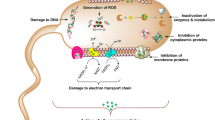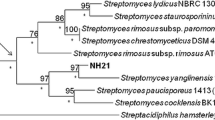Abstract
Biofilm development by bacteria is a serious issue in many different sectors, including the food, pharmaceutical, water, petroleum, and others. Because biofilms are difficult to remove due to their capacity to survive in bad environments, attempts were undertaken throughout this work to biologically manufacture gold nanoparticles with possible antibiofilm capabilities. During this study, 19 morphologically distinct fungal cultures were isolated from soil samples and used to synthesize gold nanoparticles. Among 19 fungi, 7 were producing gold nanoparticles and these particles were subjected to antimicrobial activity. Among 7 gold nanoparticles, nanoparticles synthesized from S2-10 isolate of fungi exhibited high antimicrobial activity toward biofilm-forming drug-resistant bacteria including Klebsiella pneumoniae (14.6 ± 0.57 mm), Aeromonas hydrophila (13.3 ± 0.57 mm) and Escherichia coli (10.0 ± 1.0 mm), and was used for further studies. The chosen nanoparticle also shown strong anti-biofilm action against test microorganisms on a variety of material substrates, including plastic, metal, and glass. These nanoparticles also exhibited inhibition of microcolony/initial biofilm, mature and preformed biofilm formed by Klebsiella pneumoniae (53.42 ± 4.45%, 62.14 ± 7.45%, and 24.12 ± 9.87%, respectively), Aeromonas hydrophila (43.89 ± 0.95%, 59.79 ± 1.19%, and 54.85 ± 6.50%, respectively) and Escherichia coli (45.28 ± 6.88%, 45.17 ± 3.94%, and 32.39 ± 4.16%, respectively). The physicochemical characterization of potential nanoparticles was conducted using UV–visible Spectrophotometer, X-ray diffractionSpectroscopy (XRD), Energy Dispersive X-ray (EDX) spectroscopy, Fourier Transform Infrared Spectroscopy (FTIR), and Scanning Electron Microscopy (SEM). These physicochemical analyses confirmed the formation of gold nanoparticles which were found to be spherical in shape with the size between 30 and 40 nm. Furthermore, the potential fungal isolate S2-10 was characterized as Aspergillus niger isolate CJ14 with the help of morphological and molecular techniques and deposited at National Center for Biotechnology Information (NCBI) (Accession number MN519438.1). Hence, it can be concluded that the gold nanoparticles produced using A. niger isolate CJ14 contain significant antibiofilm properties and can be used for developing antibiofilm products for future applications.










Similar content being viewed by others

References
Ahmed S, Ikram S (2016) Biosynthesis of gold nanoparticles: a green approach. J Photochem Photobiol b 161:141–153. https://doi.org/10.1016/j.jphotobiol.2016.04.034
Balakumaran MD, Ramachandran R, Balashanmugam P, Mukeshkumar DJ, Kalaichelvan PT (2016) Mycosynthesis of silver and gold nanoparticles: optimization, characterization and antimicrobial activity against human pathogens. Microbiol Res 182:8–20. https://doi.org/10.1016/j.micres.2015.09.009
Battin TJ, Besemer K, Bengtsson MM, Romani AM, Packmann AI (2016) The ecology and biogeochemistry of stream biofilms. Nat Rev Microbiol 14:251–263. https://doi.org/10.1038/nrmicro.2016.15
Chen Y, Cao S, Chai Y, Clardy J, Kolter R, Guo JH, Losick R (2012) A Bacillus subtilis sensor kinase involved in triggering biofilm formation on the roots of tomato plants. Mol Microbiol 85:418–430. https://doi.org/10.1111/j.1365-2958.2012.08109.x
Clinical and Laboratory Standards Institute (CLSI) (2021) Performance standards for antimicrobial susceptibility testing. CLSI M100, 31th Ed. USA.
Cortie M (2004) The weird world of nanoscale gold. Gold Bulletin 37:12–19. https://doi.org/10.1007/BF03215512
Cui Y, Zhao Y, Tian Y, Zhang W, Lü X, Jiang X (2012) The molecular mechanism of action of bactericidal gold nanoparticles on Escherichia coli. Biomaterials 33:2327–2333. https://doi.org/10.1016/j.biomaterials.2011.11.057
Donlan R, Costerton J (2002) Biofilms: survival mechanisms of clinically relevant microorganisms. Clin Microbiol Rev 15:167–193. https://doi.org/10.1128/CMR.15.2.167-193.2002
Dorcheh SK, Vahabi K (2016) Biosynthesis of nanoparticles by fungi: Large-scale production. In: Mérillon JM, Ramawat K (eds) Fungal Metabolites, 1st edn. Springer, Cham, pp 395–414
Edwards KJ, Bond PL, Gihring TM, Banfield JF (2000) An archaeal iron-oxidizing extr eme acidophile important in acid mine drainage. Sci. https://doi.org/10.1126/science.287.5459.1796
Ferreira G, Rosalen P, Peixoto L, Pérez A, Carlo F, Castellano L, de Lima JM, Freires IA, de Oliveira LE, de Castro RD (2017) Antibiofilm activity and mechanism of action of the disinfectant chloramine T on Candida spp., and its toxicity against human cells. Molecules. https://doi.org/10.3390/molecules22091527
Fitridge I, Dempster T, Guenther J, de Nys R (2012) The impact and control of biofouling in marine aquaculture: a review. Biofouling 28:649–669. https://doi.org/10.1080/08927014.2012.700478
Fux C, Costerton J, Stewart P, Stoodley P (2005) Survival strategies of infectious biofilms. Trends Microbiol 13:34–40. https://doi.org/10.1016/j.tim.2004.11.010
Head IM (2017) Microorganisms in the Oil and Gas Industry. In: Skovhus TL, Enning D, Lee JS (eds) Microbiologically influenced corrosion in the upstream oil and gas industry, 1st edn. CRC Press, New York, pp 58–70
Honary S, Gharaei-Fathabad E, Barabadi H, Naghibi F (2013) Fungus-mediated synthesis of gold nanoparticles: a novel biological approach to nanoparticle synthesis. J Nanosci Nanotechnol. https://doi.org/10.1166/jnn.2013.5989
Ibrahem KH, Salman JAS, Ali FA (2014) Effect of titanium nanoparticles biosynthesis by Lactobacillus crispatus on urease, hemolysin & biofilm forming by some bacteria causing recurrent UTI in Iraqi women. Europ Sci J 10:324–338
Ingle AP, Duran N, Rai M (2014) Bioactivity, mechanism of action, and cytotoxicity of copper-based nanoparticles: a review. Appl Microbiol Biotechnol 98:1001–1009. https://doi.org/10.1007/s00253-013-5422-8
Jamal M, Ahmad W, Andleeb S, Jalil F, Imran M, Nawaz MA, Hussain T, Ali M, Rafiq M, Kamil MA (2018) Bacterial biofilm and associated infections. J Chin Med Assoc 81:7–11. https://doi.org/10.1016/j.jcma.2017.07.012
Kalishwaralal K, BarathManiKanth S, Pandian SRK, Deepak V, Gurunathan S (2010) Silver nanoparticles impede the biofilm formation by Pseudomonas aeruginosa and Staphylococcus epidermidis. Colloids Surf B Biointerfaces 79:340–344. https://doi.org/10.1016/j.colsurfb.2010.04.014
Karthik L, Kumar G, Keswani T, Bhattacharyya A, Reddy B, Rao KVB (2013) Marine actinobacterial mediated gold nanoparticles synthesis and their antimalarial activity. Nanomedicine 9:951–960. https://doi.org/10.1016/j.nano.2013.02.002
Katas H, Lim CS, Azlan AYHN, Buang F, Busra MFM (2019) Antibacterial activity of biosynthesized gold nanoparticles using biomolecules from Lignosus rhinocerotis and Chitosan. Saudi Pharm J 27:283–292. https://doi.org/10.1016/j.jsps.2018.11.010
Kaur T, Putatunda C, Vyas A, Kumar G (2021) Zinc oxide nanoparticles inhibit bacterial biofilm formation via altering cell membrane permeability. Prep Biochem Biotechnol 51:309–319. https://doi.org/10.1080/10826068.2020.1815057
Khan AU, Yuan Q, Wei Y, Khan GM, Khan ZUH, Khan S, Ali F, Tahir K, Ahmad A, Khan FU (2016) Photocatalytic and antibacterial response of biosynthesized gold nanoparticles. J Photochem and Photobiol B 162:273–277. https://doi.org/10.1016/j.jphotobiol.2016.06.055
Khan I, Saeed K, Khan I (2019) Nanoparticles: properties, applications and toxicities. Arab J Chem 12:908–931. https://doi.org/10.1016/j.arabjc.2017.05.011
Kim JS, Kuk E, Yu KN, Kim JH, Park SJ, Lee HJ, Kim SH, Park YK, Park YH, Hwang CY, Kim YK (2007) Antimicrobial effects of silver nanoparticles. Nanomedicine 3:95–101. https://doi.org/10.1016/j.nano.2006.12.001
Kitching M, Ramani M, Marsili E (2015) Fungal biosynthesis of gold nanoparticles: mechanism and scale up. Microb Biotechnol 8:904–917. https://doi.org/10.1111/1751-7915.12151
Kolodkin-Gal I, Romero D, Cao S, Clardy J, Kolter R, Losick R (2010) D-Amino acids trigger biofilm disassembly. Science 328:627–629. https://doi.org/10.1126/science.1188628
Kumar G, Karthik L, Rao KVB (2010) Antibacterial activity of aqueous extract of Calotropis gigantea leaves–An in vitro study. Int Journal of Pharm Sci Rev Res 4:141–144
Lv XC, Huang ZQ, Zhang W, Rao PF, Ni L (2012) Identification and characterization of filamentous fungi isolated from fermentation starters for Hong Qu glutinous rice wine brewin. J Gen Appl Microbiol 58:33–42. https://doi.org/10.2323/jgam.58.33
Maddah H, Chogle A (2017) Biofouling in reverse osmosis: phenomena, monitoring, controlling and remediation. Appl Water Sci 7:2637–2651. https://doi.org/10.1007/s13201-016-0493-1
Mazumdar A, Gurung N, Phulera S, Mathew J, Kumar G, Karthik L, Rao KVB (2012) Evaluation of antimicrobial activity of Ipomoea fistulosa, Furcreae foetida and Barleria mysorensis: an in vitro study. Research Journal of Pharmacy and Technology 5:1081–1084
Menon S, Rajeshkumar V, Kumar S (2017) A review on biogenic synthesis of gold nanoparticles, characterization, and its applications. Resour-Eff Technol 3:516–527. https://doi.org/10.1016/j.reffit.2017.08.002
Milan C, Agostinetto A, Conceição RCS, Gonzalez HL, Timm CD (2015) Sanitizer resistance of biofilm-forming Salmonella isolated from meat products. Arq Bras Med Vet Zootec 67:642–646. https://doi.org/10.1590/1678-7298
Miranda AF, Ramkumar N, Andriotis C, Höltkemeier T, Yasmin A, Rochfort S, Wlodkowic D, Morrison P, Roddick F, Spangenberg G, Lal B (2017) Applications of microalgal biofilms for wastewater treatment and bioenergy production. Biotechnol Biofuels 10:1–23. https://doi.org/10.1186/s13068-017-0798-9
Passos da Silva D, Schofield MC, Parsek MR, Tseng BS (2017) An update on the sociomicrobiology of quorum sensing in gram-negative biofilm development. Pathogens 6:51. https://doi.org/10.3390/pathogens6040051
Quatrin PM, Comin VM, Lopes LQS, Gündel A, Vaucher RDA, Santos RCV (2015) Evaluation of different substrates for in vitro biofilm formation by Pseudomonas aeruginosa. Disciplinarum Scientia 16:191–203
Rai M, Yadav A, Gade A (2009) Silver nanoparticles as a new generation of antimicrobials. Biotechnol Adv 27:76–83. https://doi.org/10.1016/j.biotechadv.2008.09.002
Ramos MADS, SilvaPB Da, Sposito L, De Toledo LG, Bonifacio BV, Rodero CF, Dos Santos KC, Chorilli M, Bauab TM (2018) Nanotechnology-based drug delivery systems for control of microbial biofilms: a review. Int J Nanomedicine 13:1179–1213. https://doi.org/10.2147/IJN.S146195
Römling U, Kjelleberg S, Normark S, Nyman L, Uhlin BE, Åkerlund B (2014) Microbial biofilm formation: a need to act. J Intern Med 276:98–110. https://doi.org/10.1111/joim.12242
Sastry M, Ahmad A, Khan MI, Kumar R (2003) Biosynthesis of metal nanoparticles using fungi and actinomycete. Curr Sci 85:162–170
Schultz MP, Bendick JA, Holm ER, Hertel WM (2011) Economic impact of biofouling on a naval surface ship. Biofouling 27:87–98. https://doi.org/10.1080/08927014.2010.542809
Shamaila S, Zafar N, Riaz S, Sharif R, Nazir J, Naseem S (2016) Gold nanoparticles: an efficient antimicrobial agent against enteric bacterial human pathogens. Nanomaterials 6:71. https://doi.org/10.3390/nano6040071
Sharma D, Misba L, Khan AU (2019) Antibiotics versus biofilm: an emerging battleground in microbial communities. Antimicrob Resist Infect Control 8:76. https://doi.org/10.1186/s13756-019-0533-3
Sirelkhatim A, Mahmud S, Seeni A, Kaus NHM, Ann LC, Bakhori SKM, Hasan H, Mohamad D (2015) Review on zinc oxide nanoparticles: antibacterial activity and toxicity mechanism. Nanomicro Lett 7:219–242. https://doi.org/10.1007/s40820-015-0040-x
Stal LJ (2012) Cyanobacterial mats and stromatolites. In: Whitton B (ed) Ecology of Cyanobacteria II. Springer, Dordrecht, pp 65–125
Stepanović S, Vuković D, Dakić I, Savić B, Švabić-Vlahović M (2000) A modified microtiter-plate test for quantification of staphylococcal biofilm formation. J Microbiol Methods 40:175–179. https://doi.org/10.1016/S0167-7012(00)00122-6
Stewart PS (2002) Mechanisms of antibiotic resistance in bacterial biofilms. Int J Med Microbiol 292:107–113. https://doi.org/10.1078/1438-4221-00196
Timoszyk A (2018) A review of the biological synthesis of gold nanoparticles using fruit extracts: scientific potential and application. Bull Mater Sci 41:1–11. https://doi.org/10.1007/s12034-018-1673-4
Tyagi H, Kushwaha A, Kumar A, Aslam M (2016) A facile pH controlled citrate-based reduction method for gold nanoparticle synthesis at room temperature. Nanoscale Res Lett 11:1–11. https://doi.org/10.1186/s11671-016-1576-5
Ünal Turhan E, Erginkaya Z, Korukluoğlu M, Konuray G (2019) Beneficial biofilm applications in food and agricultural industry. In: Malik A, Erginkaya Z, Erten H (eds) Health and Safety Aspects of Food Processing Technologies. Springer, Cham
Wuana RA, Okieimen FE (2011) Heavy metals in contaminated soils: a review of sources, chemistry, risks and best available strategies for remediation. Int Schol Res Not. https://doi.org/10.5402/2011/402647
Zhou Y, Kong Y, Kundu S, Cirillo J, Liang H (2012) Antibacterial activities of gold and silver nanoparticles against Escherichia coli and bacillus Calmette-Guérin. J Nanobiotechnology 10:19. https://doi.org/10.1186/1477-3155-10-19
Zimlichman E, Henderson D, Tamir O, Franz C, Song P, Yamin CK, Keohane C, Denham CR, Bates DW (2013) Health care-associated infections: a meta-analysis of costs and financial impact on the US healthcare system. JAMA Intern Med 173:2039–2046. https://doi.org/10.1001/jamainternmed.2013.9763
Acknowledgements
The authors wish to thank Lovely Professional University, Phagwara, Punjab, India for providing necessary facilities to carry out this work.
Funding
The authors have not disclosed any funding.
Author information
Authors and Affiliations
Contributions
C.J. Was involved in conducting the experiment, data collection and rough draft preparation G.K. was involved in project desining, data analysis, and finalization of manuscript
Corresponding author
Ethics declarations
Conflict of interest
The authors declare that they have no conflict of interest.
Additional information
Communicated by Erko Stackebrandt.
Publisher's Note
Springer Nature remains neutral with regard to jurisdictional claims in published maps and institutional affiliations.
Supplementary Information
Below is the link to the electronic supplementary material.
Rights and permissions
Springer Nature or its licensor (e.g. a society or other partner) holds exclusive rights to this article under a publishing agreement with the author(s) or other rightsholder(s); author self-archiving of the accepted manuscript version of this article is solely governed by the terms of such publishing agreement and applicable law.
About this article
Cite this article
James, C., Kumar, G. Biosynthesis of gold nanoparticles and inhibition of various stages of bacterial biofilms formed by drug-resistant Aeromonas hydrophila, Escherichia coli, and Klebsiella pneumoniae. Arch Microbiol 204, 719 (2022). https://doi.org/10.1007/s00203-022-03325-7
Received:
Revised:
Accepted:
Published:
DOI: https://doi.org/10.1007/s00203-022-03325-7



